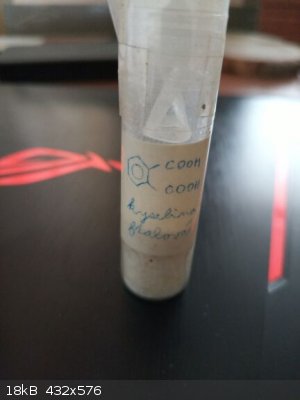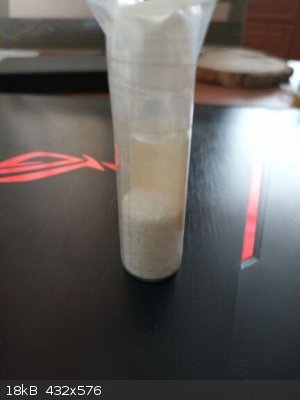reactofurnace
Hazard to Self
 
Posts: 76
Registered: 17-7-2015
Member Is Offline
Mood: Volatile
|
|
Phthalic acid synthesis
Can anyone suggest how to synthesize phthalic acid using a naphthalene precursor. Wikipedia makes mention of the oxidation of naphthalene using
dichromate. Can anyone provide reaction conditions for this? and what solvents are best to use. Is this an oxidative cleavage type rxn, if so does
anyone know the mechanism.
Also saw this route to making phthalic acid from naphthalene: https://www.prepchem.com/synthesis-of-phthalic-acid/
But the procedure seems relatively dangerous and out of my comfort zone for a home prep.
|
|
|
Syn the Sizer
National Hazard
   
Posts: 591
Registered: 12-11-2019
Location: Canada
Member Is Offline
|
|
Hello, I am sure it is similar to oxidizing xylenes. It can also be done using KMnO4 as a less toxic alternative. When you oxidize
naphthalene, it should oxidize the first carbons off the benzene ring creating 2 carboxylic groups.
Here are a couple links to videos, one is oxidizing o-xylene and the other oxidizing xylenes and separating the o isomer.
https://www.youtube.com/watch?v=PAARYmBYudg
https://www.youtube.com/watch?v=w5VDZI09Z00
|
|
|
Fery
National Hazard
   
Posts: 990
Registered: 27-8-2019
Location: Czechoslovakia
Member Is Offline
|
|
Our forum member Prepic asked me to post the preparation of phthalic acid from naphtalene + KMnO4.
There are already 3 old threads discussing the same topic:
https://www.sciencemadness.org/whisper/viewthread.php?tid=65...
https://www.sciencemadness.org/whisper/viewthread.php?tid=87...
https://www.sciencemadness.org/whisper/viewthread.php?tid=17...
I don't wan't to open new thread for that so I post it here. I would like to kindly ask moderator(s) to eventually move to appropriate place / merge /
split etc.
Here the method which I used long time ago - scanned page from the book and its translation into English:
Attachment: 256_257.tif (524kB)
This file has been downloaded 256 times
naphtalene 2,6 g (0,02 mol)
KMnO4 16g (0,10 mol)
conc. H2SO4 (I certainly used diluted accumulator 38% H2SO4 because as 15 years young boy I hadn't access to conc. acid... well I had 1 L bottle thank
to my schoolmate, but also plenty of accumulator acid which was possible to buy in drugstore, so certainly used accumulator acid keeping concentrated
acid to experiments where diluted couldn't be used)
In 250 ml RBF with condenser attached (I suggest Liebig with wide tube and not too long, certainly shorter than your longest glass rod) is heated
mixture of 2,6 g naphtalene, 16 g KMnO4 and 160 ml of water. It is heated until disappeareance of violet color of KMnO4 (this is hard to observe as
MnO2 prevents to see the color of water solution, it is necessary to let MnO2 to settle a little and observe the clear liquid above it) and until the
liquid loses color above the settled MnO2 (1,5 - 2 hours). It is necessary to periodically stop the water circulation through condenser and push
sublimed naphtalene back into the flask using glass rod. After finishing heating MnO2 is filtered out, filtrate boiled down to 1/3 of its original
volume (to approximatelly 60 ml), 4 ml of conc. H2SO4 is added (I certainly added equivalent amount of 38% H2SO4 and boiled the volume to 50 ml as the
volume of the diluted acid was bigger than concentrated acid). While still hot the paste of MnO2 is added until it dissolved (IIRC not too much of it
dissolved and the solution soon started to contain suspension of MnO2 particles). Already during the addition the phthtalic acid starts to precipitate
in a form of crystalline product. Reaction mixture is heated to boil and such amount of water is added which dissolves the precipitated product. After
finished oxidation a little of active charcoal is added and hot solution is filtered. Filtrate is concentrated and let to crystallize. Phthalic acid
crystallizes in a form of white crystals, which are sucked off and dried between 2 sheets of filter paper. By its sublimation is its anhydride is
obtained, m.p. 128 C. Yield 2 g which is 60,6% of theory. Phthalic acid is white crystalline substance with m.p. 203 C, only very slightly soluble in
water, soluble in alcohol, little in ether.
As I did not have camera that time, I don't have pictures of the experiment itself. But I remember I "cooked" the reaction on a wood stove in my
gradma summer kitchen, so the boil was only very mild, certainly not vigorous. I also remember, that I waited for KMnO4 discoloration for maybe 4-5
hours and only then realized, that it already reacted and violet color was gone, maybe already hours ago, just the colorlessness was not visible due
to MnO2. I also suggest not to boil it too vigorously as then naphtalene sublimes faster. Also stirring should improve performance (mg. stirrer or at
least swirling the apparatus using hand - I did that manual swirling occasionally as melted naphtalene is as a top layer and it is necessary to
increase surface contact to made it to react). Maybe the boil itself is sufficient to mix both phases, but vigorous boil = too fast sublimation of
naphtalene which settles in condenser. I wonder whether it couldn't be performed in a flask without condenser, sitting on mg. stirrer (or at worst
periodically swirl in a hand) with its neck just covered by a plastic foil, at such temp just below the boil (e.g. in boiling water bath so the
content in flask couldn't reach 100 C), so the plastic foil keeps the flask closed and prevents naphtalene loses by escaping.
I still have the vial with the product, the vial is 10 ml. Pictures made just now attached. The label is still readable although it already lost some
color and the paper is somewhat yellowish.
 
I found solubilities of phthalic acid in water here:
https://www.bc.edu/content/dam/bc1/schools/mcas/Chemistry/pd...
"Phthalic acid is very soluble in boiling water, 18 g/100 mL, and is much less soluble in chilled (14°C) water, 0.54 g/100 mL."
[Edited on 9-4-2021 by Fery]
|
|
|
Fery
National Hazard
   
Posts: 990
Registered: 27-8-2019
Location: Czechoslovakia
Member Is Offline
|
|
Here I found oxidation of naphtalene with KMnO4 + H2SO4 in acetic acid : H2O 1:1
https://www.researchgate.net/publication/312117264_Kinetic_a...
https://www.researchgate.net/profile/Bijudas-K/publication/3...
this study focused not on yield but on mechanism and reaction speed
acetic acid dissolves naphtalene better than water
worth of trying for producing phthalic acid and focusing on yield
Attachment: 40-0581116.pdf (591kB)
This file has been downloaded 241 times
the bad solubility of naphtalene in water really annoyed me decades ago (2 phases = bad contact of molten naphtalene floating on top of the oxidizing
solution) and also crystals of naphtalene in condenser (maybe if using enough acetic acid naphtalene would be dissolved by acetic acid in the
condenser)
here comparison with KMnO4 alkaline oxidation to phtalonic acid instead of phtalic acid:
https://sci-hub.st/10.1021/j150083a001
Attachment: daly1906.pdf (675kB)
This file has been downloaded 200 times
also interesting oxidation to phthaldehydic acid instead of phthalic acid here:
http://www.orgsyn.org/demo.aspx?prep=cv2p0523
http://www.orgsyn.org/Content/pdfs/procedures/cv2p0523.pdf
Attachment: cv2p0523.pdf (319kB)
This file has been downloaded 173 times
|
|
|
Triflic Acid
Hazard to Others
  
Posts: 486
Registered: 27-9-2020
Member Is Offline
Mood: Slowly Oxidizing into Oblivion
|
|
An interesting thought just popped into my head. What if someone where to put a catalytic amount of of dichromate into an acidic solution of whatever
they wanted to oxidize and then bubbled ozone or something through the solution, so only a bit of dichromate is needed. Saves on the cost, and still
has the ease of a Jones oxidation. No manganese oxides or expensive amounts of chromates.
There wasn't a fire, we just had an uncontrolled rapid oxidation event at the power plant.
|
|
|
Oxy
Hazard to Others
  
Posts: 140
Registered: 1-12-2020
Member Is Offline
|
|
Ozone is nasty gas and I would avoid it if possible. Despite it's toxicity the products of organics reacting with it may be explosive and toxic also.
What else - you can't really control the reaction as you don't know if your substrate is reacting with ozone or dichromate.
However it is easy to do when passing electric current through the solution. You can then use a relatively small amount of oxidizer (like Ce4+) which
will be continuously regenerated
|
|
|
Triflic Acid
Hazard to Others
  
Posts: 486
Registered: 27-9-2020
Member Is Offline
Mood: Slowly Oxidizing into Oblivion
|
|
Yeah, the electric current method seems smarter.
There wasn't a fire, we just had an uncontrolled rapid oxidation event at the power plant.
|
|
|
Fery
National Hazard
   
Posts: 990
Registered: 27-8-2019
Location: Czechoslovakia
Member Is Offline
|
|
And acetic acid is quite good solvent for naphtalene and also for some ions, worth of trying the electrolysis...
|
|
|